Preparation and Presentation of the Exhibition on April 28, 1958 at the Iris Clert Gallery, 3 rue des Beaux-Arts, Paris
“The Refinement of Sensibility in the First Material State into Stabilized Pictorial Sensibility”
The Pneumatic Period
(Some details have been be omitted)
The object of this attempt is to create, to establish, and to impress upon the viewing public a sensible pictorial state within the confines of an art gallery; in other words, the creation of an environment, of a real pictorial climate, therefore one that is invisible. This invisible pictorial state within the space of the gallery must literally become what until now has been given as the best general definition of painting: radiance. For the creative act to success, the immaterialization of the invisible and intangible canvas must act upon the sensible vehicles or bodies of the gallery visitors with much more efficiency than ordinary, physical, representational paintings. The latter, if they are of good quality, are also endowed some special pictorial essence and affective presence, that is, with sensibility, but it is transmitted by the suggestion of every physical and psychological appearance of the painting, by its lines, contours, forms, composition, juxtaposition of colors, etc. These intermediaries are now no longer needed: one is literally impregnated with the pictorial sensibility, refined and stabilized beforehand by the painter in a given space. It is a direct and immediate perception and assimilation without other effects, without gadgets or hoaxes. To this effect, then, we design with Iris Clert the invitation to the opening reception with a text by Pierre Restany. This brilliantly laconic text is very clear, and, considering the importance of this exhibition for the history of art, we decide to print the invitation in an informal yet stately English format, and, above all, engraved, so that the blind can read it (they are all blind!); this is said with no pejorative or aggressive intent. The ink used will, of course, be blue, imprinted on a white card.
This on appearance symbolist method is not actually symbolist, since, in fact, everything occurs in space. It is good to give a first impression of what the exhibition will be: a space of blue sensibility within the framework of the whitened walls of the gallery. We also decide to send the invitations in a stamped envelop with the formidable blue stamp of the last year’s Blue Period. Iris Clert invites you to honor with all your affective presence the lucid and positive advent of a certain reign of the sensible. This manifestation of perceptive synthesis testifies to the pictorial quest for ecstatic and immediately communicable emotion in Yves Klein’s work (Opening reception, 3, rue des Beaux- Arts, Monday, April 28 from nine p.m. to midnight). Pierre Restany 3,500 invitations were mailed, 3,000 in Paris alone. We also decided to add a kind of free admissions ticket, clearly noting that without that special little card the price of admission would be 1,500 francs per person. M ______________________________________________________________________________________________________ ____________________________________________________
Invitation for
TWO PERSONS
from April 28th to May 5th
for anyone without this card
the admissions price will be 1,500 Francs
This ploy is required because, although all the pictorial sensibility I display is for sale, piece by piece or as a whole, the spectators endowed with a body or vehicle receptive to sensibility would be able, despite all my effort and all my strength to keep the entire exhibition in place, to rob me, by impregnation, of some degree of intensity, whether consciously or not,. And that, above all, must be paid for. 1,500 francs is not really that much, after all.
We then decide upon the preparation and material presentation of the exhibition. (For publicity: two large posters are planned for the Place St-Germain-des-Prés, for five days only, blue letters engraved on a white background, text: Gallery IRIS CLERT, 3, rue des Beaux-Arts, YVES THE MONOCHROME, from the April 28 to May 5. After this we announce the exhibition with small ads in the Paris editions of ARTS and COMBAT as well as in the American edition of ARTS.)
The IRIS CLERT Gallery is quite small, twenty square meters, with one door and one store window to the street. We will close the street entrance and provide access for the public through a small door off the entrance corridor of the building, which leads into the back of the gallery. From the street it will be impossible to see anything other than the color blue, for I shall paint the windows in the blue of last year’s blue period. In front of the building entrance, through which the public will have access to the gallery by way of the corridor, I will place a monumental dais draped in fabric of the same dark ultramarine shade of blue.
On the evening of the opening, beneath this dais on each side of the entrance, Republican Guards in formal presidential dress uniforms will be stationed. (This will be required to bestow upon the exhibition the official character I aspire and also because the true principle of the Republic, were it applied, pleases me, even though I find it incomplete nowadays). We shall receive the public in the corridor, which measures approximately 32 square meters, where a blue cocktail will be served (prepared by the bar of La Coupole in MONTPARNASSE: gin, Cointreau, methylene blue).
Once in the corridor, the visitors will see on the left-hand wall a large blue tapestry that conceals the small access door into the gallery.
We are also planning to have four private guards prepared to handle any developments in dealing with up to 3,000 people.
This is quite urgent and necessary, especially since I anticipate acts of vandalism. They are trained in riot control and will be instructed to treat the public with the utmost courtesy as long as it conducts itself decently and does not behave too disagreeably.
Two of these bodyguards will be stationed outside at the entrance of the building, together with the Republican Guards, to verify the invitations, while the other two, standing on each side of the tapestry at the corridor gallery entrance, will admit the public in groups of ten at time into the gallery. As for myself, I shall hold court inside, asking people to remain no longer than two or three minutes in order to allow everyone to enter.
Preparation of the gallery: in order to refine the ambiance of this gallery – its pictorial sensibility in the first material state – to an individual, autonomous, and stabilized pictorial climate, I must, on one hand, bleach the gallery to wash away the impregnations with the numerous preceding expositions. In painting the walls white I wish not only to purify the space but, above all, to transform it, through this action and gesture temporarily into my work space, my studio.
I believe I shall reach my goal if I work conscious of my act and filled with enthusiasm over the principle of the demonstration by applying one or several coats of paint to the gallery walls with my usual technique, like a great painting, with the best of myself and all the good intention possible, using pure white lithopone [zinc sulfide] mixed with my special varnish consisting of alcohol, acetone, and vinyl resin (which does not kill the pure pigment when it is fixed onto the supporting surface), and applying enamel lacquer with a roller.
While not playing the role of a house painter, which is to say, allowing myself to proceed at my own pace and in my own manner of painting, free and perhaps slightly distorted by my sensual nature, I believe that the pictorial space that I had succeeded to stabilize previously in front of and around my monochrome paintings will thenceforth be well established in the space of the gallery. My active presence during the execution in the gallery space will create the climate and the radiating pictorial environment that habitually permeates the studio of the artist endowed with a true power; a sensible density that is abstract yet real, existing and living, by itself and for itself, in each location. For that reason nothing must shock the viewer in the gallery, which however should not be too bare deliberately. Thus, no furniture; we will leave the display case built into the rear left wall. I will simply paint it white like everything else, except for its metal fixtures. I will leave the cupboard under the gallery window facing the street, paint its wood surfaces white in the same way, and cover its base with white fabric. The glass of the display case and the door opening onto the street, undesirable, will also be painted white. Everything will be painted white to receive the pictorial climate of the sensibility of dematerialized blue. I will paint neither the ceiling nor the floor; I will leave the new charcoal-gray floor carpeting in place, which Iris had installed a few days ago. To make it extremely clear that I have abandoned the material and physical aspects of the color blue, waste and coagulated blood issued from the first matter and sensibility of space, I wish to obtain from the Prefecture of the Seine and from Electricité de France (EDF) the authorization to illuminate in the obelisk of the Place de la Concorde in blue light. By placing blue filters over the light projectors already installed, the entire obelisk can be illuminated while leaving its base dark. This will restore to the monument all the mystical brilliance of ancient antiquity and contribute, at the same time, a solution to the perennial problem that the “base” has always posed as sculpture. In effect, thus illuminated, the obelisk will soar into space, immutable and static, in a monumental movement of the affective imagination, over the entire expanse of the Place de la Concorde, above the prehistoric gas-lit streetlamps into the night, like an enormous unpunctuated exclamation mark! In this way, the tangible and visible blue will be outside, outdoors, in the street, and in indoors will be the dematerialization of blue: the colored space, which is not seen, but with which one is impregnated. On Wednesday, May 23rd (sic), at 11:00 p.m., IRIS CLERT and I will meet with the technicians from the EDF on the Place de la Concorde, assuming that the authorization to illuminate the obelisk in blue for the evening of our opening reception will have been granted by the prefecture. On our arrival we will be exalted with enthusiasm, already from afar, by this extraordinary vision of such rare and exceptional quality. The surfaces covered by hieroglyphs will become the pictorial material of a profound and mysterious richness that is unheard of and bewildering. It is grandiose. The tests are conclusive on all counts. Saturday morning, at 8:00 a.m., I set myself to work in the gallery. I have forty-eight hours to paint the entire space, all by myself. By Sunday everything must be done in order to air it out properly before the opening reception. The dais will be installed on Monday morning. At 2:00 p.m. on Monday afternoon, I will prepare my inaugural speech on the movement of sensibility, which I will deliver after the reception, at around 1:00 a.m., at La Coupole, among friends, during the final round of drinks. Everything is ready; at around 7:00 p.m., I am in the gallery. Suddenly, the telephone rings (during the exhibition the telephone will be placed in the corridor outside). It is the police department. A laconic voice announces to me that a decision has been made to suppress the illumination of the Obelisk on the grounds that it is too personal in character and attracting too much publicity on the radio and in the newspapers. I am crushed … I attempt to contact IRIS who has left to prepare the opening reception scheduled to begin at 9:00 p.m. I find her; she desperately rushes off to the police department, but it is too late, all the world has left, and there is nothing left to be done. The next day we learn that this brusque and unexpected decision on the part of the authorities had been brought about by offensive and abominable telephone calls of jealous individuals who had calumniously objected to this official favor that had been granted me. At 8:00 p.m. I went to La Coupole to have the Blue cocktail specially prepared for the exhibition. At 8:45 p.m. I am at the Gallery. Last preparations. At 9:00 p.m. the arrival of the Republican Guard in formal dress uniform. As soon as they arrive I offer them an honorary Blue cocktail before they assume their position to stand attention beneath the dais at the entrance. They arrive almost simultaneously with the four private security guards. I explain their duties to each of them; they recited them back to me and already the first visitors arrive … 9:30 p.m. The place is packed; the corridor is full, as well as the gallery. Outside the crowd piles up, barely managing to get inside 9:45 p.m. It is delirious. The crowd is so tightly packed that no one can make the slightest movement. I am staying inside the gallery. Every three minutes I shout out and repeat in a loud voice to those piled up in the Gallery (the private security guards no longer manages to hold them back and can no longer control the gallery entrances and exits: Ladies and gentlemen, please have the extreme kindness to agree not to stay too long in the gallery so that other visitors waiting outside can enter in their turn. 9:45 p.m. RESTANY arrives, in a car driven by BRUNING from Düsseldorf to Paris , exact at the same time as KRICKE and his wife. 9:50 p.m. I suddenly notice, in the gallery, a young man about to draw on one of the walls. I rush towards him, make him stop and ask him politely but very firmly to leave. As I accompany him to the small exit door outside of which stand the two guards (the crowd inside the gallery has fallen silent and is now watching to see what is going to happen), I shout to the guards who are in the corridor: Seize this man and throw him out! He is literally extirpated, snatched by my guards. 10:00 p.m. The police arrive in force (three full patrol cars) by way of the rue de Seine; firemen also arrive in force, just as numerously, by way of the rue Bonaparte, but they cannot move any closer through the crowd in the rue des Beaux-Arts than to the Claude Bernard Gallery. 10:10 p.m. There are between 2,500 and 3,000 spectators in the street; The police by way of the rue de Seine, the firemen by way of the rue Bonaparte try to push the crowd toward the embankments of the Seine. When a police patrol reaches the entrance of the gallery to demand an explanation of what is going on (some people, furious at having paid 1,500 francs admission but unable to see anything at all, start to complain), my body guards laconically but firmly inform them: We have our own private security to maintain order here; we have no need of you. The police patrol, without ant legal right to enter, withdraws. 10:20 p.m. the representative of the Order of Saint Sebastian arrrives in full dress (a bicorne hat with a cape emblazoned with the red cross of Malta). Many painters find themselves in the room at the same time. Camille Bryen exclaims: In sum, this is an exhibition of painters here! For the most part, the crowd enters the gallery in anger and exits from it fully satisfied. It is what the Great Press will be forced to notice officially in writing that 40% of the visitors react positively, grasped by the pictorial sensible state and seized by the intense atmosphere that reigns, terrifyingly, in the apparent void of the exposition space. 10:30 p.m. The Republican Guards are leaving, feeling nauseated; for an hour art students have slapped them familiarly on the shoulders demanding to know where they have rented their costumes and if they are movie extras! 22:50 p.m. We are out of Blue cocktails. Someone is off to La Coupole looking to get more. Two pretty Japanese women in extraordinary kimonos arrive. 11:00 p.m. The crowd outside, which had been dispersed by the police and the firemen, returns in small, exasperated groups. Inside, the place is teeming as ever. 12:30 a.m. We close up and leave for La Coupole, At La Coupole, a huge table for forty in the back. 1:00 a.m. Trembling with exhaustion I pronounce my revolutionary discourse. (see the following discourse). 1:15 a.m. IRIS passes out! The next morning. IRIS is summoned urgently to the Republican Guard. There she is submitted to a two-hour-long interrogation and is charged with an affront to the dignity of the Republic. Everything is fixed the next day when the Chief Commander of the Guard himself visits the scene (of the so-called crime according to the slanderers). The exhibition, scheduled to be open for eight days, has to be extended for an additional week. More than two hundred visitors rush each day into the interior of the century. The human experience has considerable range, almost indescribable. Certain people are not able to enter, as if deterred by an invisible wall. One of the visitors shouted to me one day from the door: I shall return when this void is full … I answer him: When it will be full, you will no longer be able to enter. Some stay inside for hours without saying a word, others tremble or start to cry. I have sold two immaterial paintings out of this exhibition. Belief me, one is not robbed when purchasing such paintings. It is I who is always robbed because I accept money. This is why, at the Hessenhuis in Anvers, in a group show with BREER, BURY, MACK, MUNARI, UECKER, PIENE, ROT, SOTO, SPOERRI and TINGUELY, I did not even want to paint one or several walls nor make any kind of figurative gesture, sweep or brush the walls with even a dry, paintless brush. NO, I simply restrained myself to presenting myself at the exhibition space on the day of the opening, announcing to everyone, in the space that was reserved for me: FIRST THERE IS NOTHING, THEN THERE IS A DEEP NOTHING, THEN THERE IS A BLUE DEPTH. (G. BACHELARD)1 At present I no longer wish that anyone purchase my work for money. I have asked, for my three pictorial states exhibited, a quantity of pure GOLD. One kilo of GOLD for each work. There it is, cut and dried at last … at last for the moment; afterwards we shall see what follows, which will not be long in coming. Because, for me, there are no more problems. As I said at the beginning of this text: I have overcome the problematics of art.
“The Refinement of Sensibility in the First Material State into Stabilized Pictorial Sensibility”
The Pneumatic Period
(Some details have been be omitted)
The object of this attempt is to create, to establish, and to impress upon the viewing public a sensible pictorial state within the confines of an art gallery; in other words, the creation of an environment, of a real pictorial climate, therefore one that is invisible. This invisible pictorial state within the space of the gallery must literally become what until now has been given as the best general definition of painting: radiance. For the creative act to success, the immaterialization of the invisible and intangible canvas must act upon the sensible vehicles or bodies of the gallery visitors with much more efficiency than ordinary, physical, representational paintings. The latter, if they are of good quality, are also endowed some special pictorial essence and affective presence, that is, with sensibility, but it is transmitted by the suggestion of every physical and psychological appearance of the painting, by its lines, contours, forms, composition, juxtaposition of colors, etc. These intermediaries are now no longer needed: one is literally impregnated with the pictorial sensibility, refined and stabilized beforehand by the painter in a given space. It is a direct and immediate perception and assimilation without other effects, without gadgets or hoaxes. To this effect, then, we design with Iris Clert the invitation to the opening reception with a text by Pierre Restany. This brilliantly laconic text is very clear, and, considering the importance of this exhibition for the history of art, we decide to print the invitation in an informal yet stately English format, and, above all, engraved, so that the blind can read it (they are all blind!); this is said with no pejorative or aggressive intent. The ink used will, of course, be blue, imprinted on a white card.
This on appearance symbolist method is not actually symbolist, since, in fact, everything occurs in space. It is good to give a first impression of what the exhibition will be: a space of blue sensibility within the framework of the whitened walls of the gallery. We also decide to send the invitations in a stamped envelop with the formidable blue stamp of the last year’s Blue Period. Iris Clert invites you to honor with all your affective presence the lucid and positive advent of a certain reign of the sensible. This manifestation of perceptive synthesis testifies to the pictorial quest for ecstatic and immediately communicable emotion in Yves Klein’s work (Opening reception, 3, rue des Beaux- Arts, Monday, April 28 from nine p.m. to midnight). Pierre Restany 3,500 invitations were mailed, 3,000 in Paris alone. We also decided to add a kind of free admissions ticket, clearly noting that without that special little card the price of admission would be 1,500 francs per person. M ______________________________________________________________________________________________________ ____________________________________________________
Invitation for
TWO PERSONS
from April 28th to May 5th
for anyone without this card
the admissions price will be 1,500 Francs
This ploy is required because, although all the pictorial sensibility I display is for sale, piece by piece or as a whole, the spectators endowed with a body or vehicle receptive to sensibility would be able, despite all my effort and all my strength to keep the entire exhibition in place, to rob me, by impregnation, of some degree of intensity, whether consciously or not,. And that, above all, must be paid for. 1,500 francs is not really that much, after all.
We then decide upon the preparation and material presentation of the exhibition. (For publicity: two large posters are planned for the Place St-Germain-des-Prés, for five days only, blue letters engraved on a white background, text: Gallery IRIS CLERT, 3, rue des Beaux-Arts, YVES THE MONOCHROME, from the April 28 to May 5. After this we announce the exhibition with small ads in the Paris editions of ARTS and COMBAT as well as in the American edition of ARTS.)
The IRIS CLERT Gallery is quite small, twenty square meters, with one door and one store window to the street. We will close the street entrance and provide access for the public through a small door off the entrance corridor of the building, which leads into the back of the gallery. From the street it will be impossible to see anything other than the color blue, for I shall paint the windows in the blue of last year’s blue period. In front of the building entrance, through which the public will have access to the gallery by way of the corridor, I will place a monumental dais draped in fabric of the same dark ultramarine shade of blue.
On the evening of the opening, beneath this dais on each side of the entrance, Republican Guards in formal presidential dress uniforms will be stationed. (This will be required to bestow upon the exhibition the official character I aspire and also because the true principle of the Republic, were it applied, pleases me, even though I find it incomplete nowadays). We shall receive the public in the corridor, which measures approximately 32 square meters, where a blue cocktail will be served (prepared by the bar of La Coupole in MONTPARNASSE: gin, Cointreau, methylene blue).
Once in the corridor, the visitors will see on the left-hand wall a large blue tapestry that conceals the small access door into the gallery.
We are also planning to have four private guards prepared to handle any developments in dealing with up to 3,000 people.
This is quite urgent and necessary, especially since I anticipate acts of vandalism. They are trained in riot control and will be instructed to treat the public with the utmost courtesy as long as it conducts itself decently and does not behave too disagreeably.
Two of these bodyguards will be stationed outside at the entrance of the building, together with the Republican Guards, to verify the invitations, while the other two, standing on each side of the tapestry at the corridor gallery entrance, will admit the public in groups of ten at time into the gallery. As for myself, I shall hold court inside, asking people to remain no longer than two or three minutes in order to allow everyone to enter.
Preparation of the gallery: in order to refine the ambiance of this gallery – its pictorial sensibility in the first material state – to an individual, autonomous, and stabilized pictorial climate, I must, on one hand, bleach the gallery to wash away the impregnations with the numerous preceding expositions. In painting the walls white I wish not only to purify the space but, above all, to transform it, through this action and gesture temporarily into my work space, my studio.
I believe I shall reach my goal if I work conscious of my act and filled with enthusiasm over the principle of the demonstration by applying one or several coats of paint to the gallery walls with my usual technique, like a great painting, with the best of myself and all the good intention possible, using pure white lithopone [zinc sulfide] mixed with my special varnish consisting of alcohol, acetone, and vinyl resin (which does not kill the pure pigment when it is fixed onto the supporting surface), and applying enamel lacquer with a roller.
While not playing the role of a house painter, which is to say, allowing myself to proceed at my own pace and in my own manner of painting, free and perhaps slightly distorted by my sensual nature, I believe that the pictorial space that I had succeeded to stabilize previously in front of and around my monochrome paintings will thenceforth be well established in the space of the gallery. My active presence during the execution in the gallery space will create the climate and the radiating pictorial environment that habitually permeates the studio of the artist endowed with a true power; a sensible density that is abstract yet real, existing and living, by itself and for itself, in each location. For that reason nothing must shock the viewer in the gallery, which however should not be too bare deliberately. Thus, no furniture; we will leave the display case built into the rear left wall. I will simply paint it white like everything else, except for its metal fixtures. I will leave the cupboard under the gallery window facing the street, paint its wood surfaces white in the same way, and cover its base with white fabric. The glass of the display case and the door opening onto the street, undesirable, will also be painted white. Everything will be painted white to receive the pictorial climate of the sensibility of dematerialized blue. I will paint neither the ceiling nor the floor; I will leave the new charcoal-gray floor carpeting in place, which Iris had installed a few days ago. To make it extremely clear that I have abandoned the material and physical aspects of the color blue, waste and coagulated blood issued from the first matter and sensibility of space, I wish to obtain from the Prefecture of the Seine and from Electricité de France (EDF) the authorization to illuminate in the obelisk of the Place de la Concorde in blue light. By placing blue filters over the light projectors already installed, the entire obelisk can be illuminated while leaving its base dark. This will restore to the monument all the mystical brilliance of ancient antiquity and contribute, at the same time, a solution to the perennial problem that the “base” has always posed as sculpture. In effect, thus illuminated, the obelisk will soar into space, immutable and static, in a monumental movement of the affective imagination, over the entire expanse of the Place de la Concorde, above the prehistoric gas-lit streetlamps into the night, like an enormous unpunctuated exclamation mark! In this way, the tangible and visible blue will be outside, outdoors, in the street, and in indoors will be the dematerialization of blue: the colored space, which is not seen, but with which one is impregnated. On Wednesday, May 23rd (sic), at 11:00 p.m., IRIS CLERT and I will meet with the technicians from the EDF on the Place de la Concorde, assuming that the authorization to illuminate the obelisk in blue for the evening of our opening reception will have been granted by the prefecture. On our arrival we will be exalted with enthusiasm, already from afar, by this extraordinary vision of such rare and exceptional quality. The surfaces covered by hieroglyphs will become the pictorial material of a profound and mysterious richness that is unheard of and bewildering. It is grandiose. The tests are conclusive on all counts. Saturday morning, at 8:00 a.m., I set myself to work in the gallery. I have forty-eight hours to paint the entire space, all by myself. By Sunday everything must be done in order to air it out properly before the opening reception. The dais will be installed on Monday morning. At 2:00 p.m. on Monday afternoon, I will prepare my inaugural speech on the movement of sensibility, which I will deliver after the reception, at around 1:00 a.m., at La Coupole, among friends, during the final round of drinks. Everything is ready; at around 7:00 p.m., I am in the gallery. Suddenly, the telephone rings (during the exhibition the telephone will be placed in the corridor outside). It is the police department. A laconic voice announces to me that a decision has been made to suppress the illumination of the Obelisk on the grounds that it is too personal in character and attracting too much publicity on the radio and in the newspapers. I am crushed … I attempt to contact IRIS who has left to prepare the opening reception scheduled to begin at 9:00 p.m. I find her; she desperately rushes off to the police department, but it is too late, all the world has left, and there is nothing left to be done. The next day we learn that this brusque and unexpected decision on the part of the authorities had been brought about by offensive and abominable telephone calls of jealous individuals who had calumniously objected to this official favor that had been granted me. At 8:00 p.m. I went to La Coupole to have the Blue cocktail specially prepared for the exhibition. At 8:45 p.m. I am at the Gallery. Last preparations. At 9:00 p.m. the arrival of the Republican Guard in formal dress uniform. As soon as they arrive I offer them an honorary Blue cocktail before they assume their position to stand attention beneath the dais at the entrance. They arrive almost simultaneously with the four private security guards. I explain their duties to each of them; they recited them back to me and already the first visitors arrive … 9:30 p.m. The place is packed; the corridor is full, as well as the gallery. Outside the crowd piles up, barely managing to get inside 9:45 p.m. It is delirious. The crowd is so tightly packed that no one can make the slightest movement. I am staying inside the gallery. Every three minutes I shout out and repeat in a loud voice to those piled up in the Gallery (the private security guards no longer manages to hold them back and can no longer control the gallery entrances and exits: Ladies and gentlemen, please have the extreme kindness to agree not to stay too long in the gallery so that other visitors waiting outside can enter in their turn. 9:45 p.m. RESTANY arrives, in a car driven by BRUNING from Düsseldorf to Paris , exact at the same time as KRICKE and his wife. 9:50 p.m. I suddenly notice, in the gallery, a young man about to draw on one of the walls. I rush towards him, make him stop and ask him politely but very firmly to leave. As I accompany him to the small exit door outside of which stand the two guards (the crowd inside the gallery has fallen silent and is now watching to see what is going to happen), I shout to the guards who are in the corridor: Seize this man and throw him out! He is literally extirpated, snatched by my guards. 10:00 p.m. The police arrive in force (three full patrol cars) by way of the rue de Seine; firemen also arrive in force, just as numerously, by way of the rue Bonaparte, but they cannot move any closer through the crowd in the rue des Beaux-Arts than to the Claude Bernard Gallery. 10:10 p.m. There are between 2,500 and 3,000 spectators in the street; The police by way of the rue de Seine, the firemen by way of the rue Bonaparte try to push the crowd toward the embankments of the Seine. When a police patrol reaches the entrance of the gallery to demand an explanation of what is going on (some people, furious at having paid 1,500 francs admission but unable to see anything at all, start to complain), my body guards laconically but firmly inform them: We have our own private security to maintain order here; we have no need of you. The police patrol, without ant legal right to enter, withdraws. 10:20 p.m. the representative of the Order of Saint Sebastian arrrives in full dress (a bicorne hat with a cape emblazoned with the red cross of Malta). Many painters find themselves in the room at the same time. Camille Bryen exclaims: In sum, this is an exhibition of painters here! For the most part, the crowd enters the gallery in anger and exits from it fully satisfied. It is what the Great Press will be forced to notice officially in writing that 40% of the visitors react positively, grasped by the pictorial sensible state and seized by the intense atmosphere that reigns, terrifyingly, in the apparent void of the exposition space. 10:30 p.m. The Republican Guards are leaving, feeling nauseated; for an hour art students have slapped them familiarly on the shoulders demanding to know where they have rented their costumes and if they are movie extras! 22:50 p.m. We are out of Blue cocktails. Someone is off to La Coupole looking to get more. Two pretty Japanese women in extraordinary kimonos arrive. 11:00 p.m. The crowd outside, which had been dispersed by the police and the firemen, returns in small, exasperated groups. Inside, the place is teeming as ever. 12:30 a.m. We close up and leave for La Coupole, At La Coupole, a huge table for forty in the back. 1:00 a.m. Trembling with exhaustion I pronounce my revolutionary discourse. (see the following discourse). 1:15 a.m. IRIS passes out! The next morning. IRIS is summoned urgently to the Republican Guard. There she is submitted to a two-hour-long interrogation and is charged with an affront to the dignity of the Republic. Everything is fixed the next day when the Chief Commander of the Guard himself visits the scene (of the so-called crime according to the slanderers). The exhibition, scheduled to be open for eight days, has to be extended for an additional week. More than two hundred visitors rush each day into the interior of the century. The human experience has considerable range, almost indescribable. Certain people are not able to enter, as if deterred by an invisible wall. One of the visitors shouted to me one day from the door: I shall return when this void is full … I answer him: When it will be full, you will no longer be able to enter. Some stay inside for hours without saying a word, others tremble or start to cry. I have sold two immaterial paintings out of this exhibition. Belief me, one is not robbed when purchasing such paintings. It is I who is always robbed because I accept money. This is why, at the Hessenhuis in Anvers, in a group show with BREER, BURY, MACK, MUNARI, UECKER, PIENE, ROT, SOTO, SPOERRI and TINGUELY, I did not even want to paint one or several walls nor make any kind of figurative gesture, sweep or brush the walls with even a dry, paintless brush. NO, I simply restrained myself to presenting myself at the exhibition space on the day of the opening, announcing to everyone, in the space that was reserved for me: FIRST THERE IS NOTHING, THEN THERE IS A DEEP NOTHING, THEN THERE IS A BLUE DEPTH. (G. BACHELARD)1 At present I no longer wish that anyone purchase my work for money. I have asked, for my three pictorial states exhibited, a quantity of pure GOLD. One kilo of GOLD for each work. There it is, cut and dried at last … at last for the moment; afterwards we shall see what follows, which will not be long in coming. Because, for me, there are no more problems. As I said at the beginning of this text: I have overcome the problematics of art.
| Technical | Tapuscrit sur papier pelure avec des annotations manuscrites |
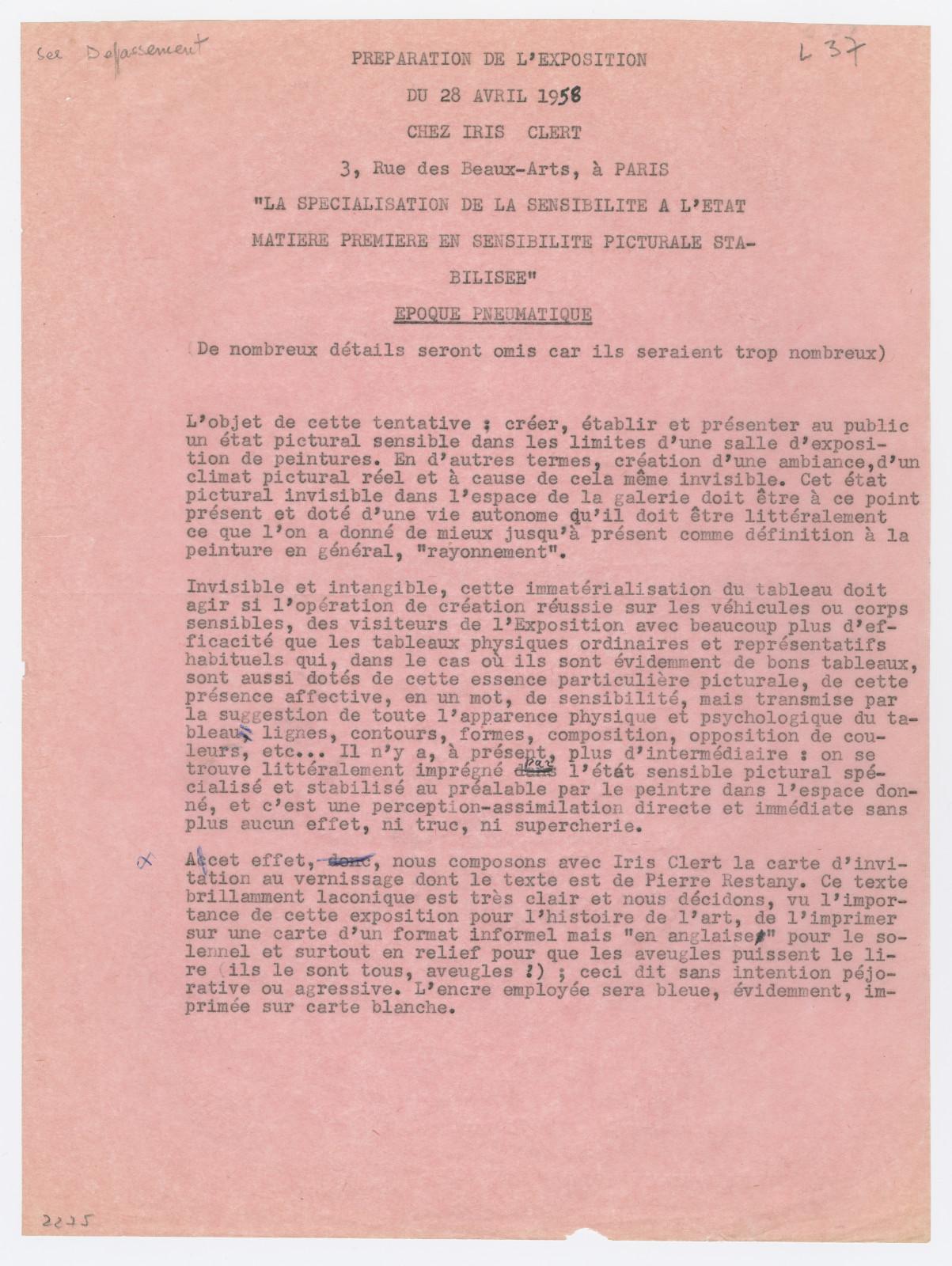
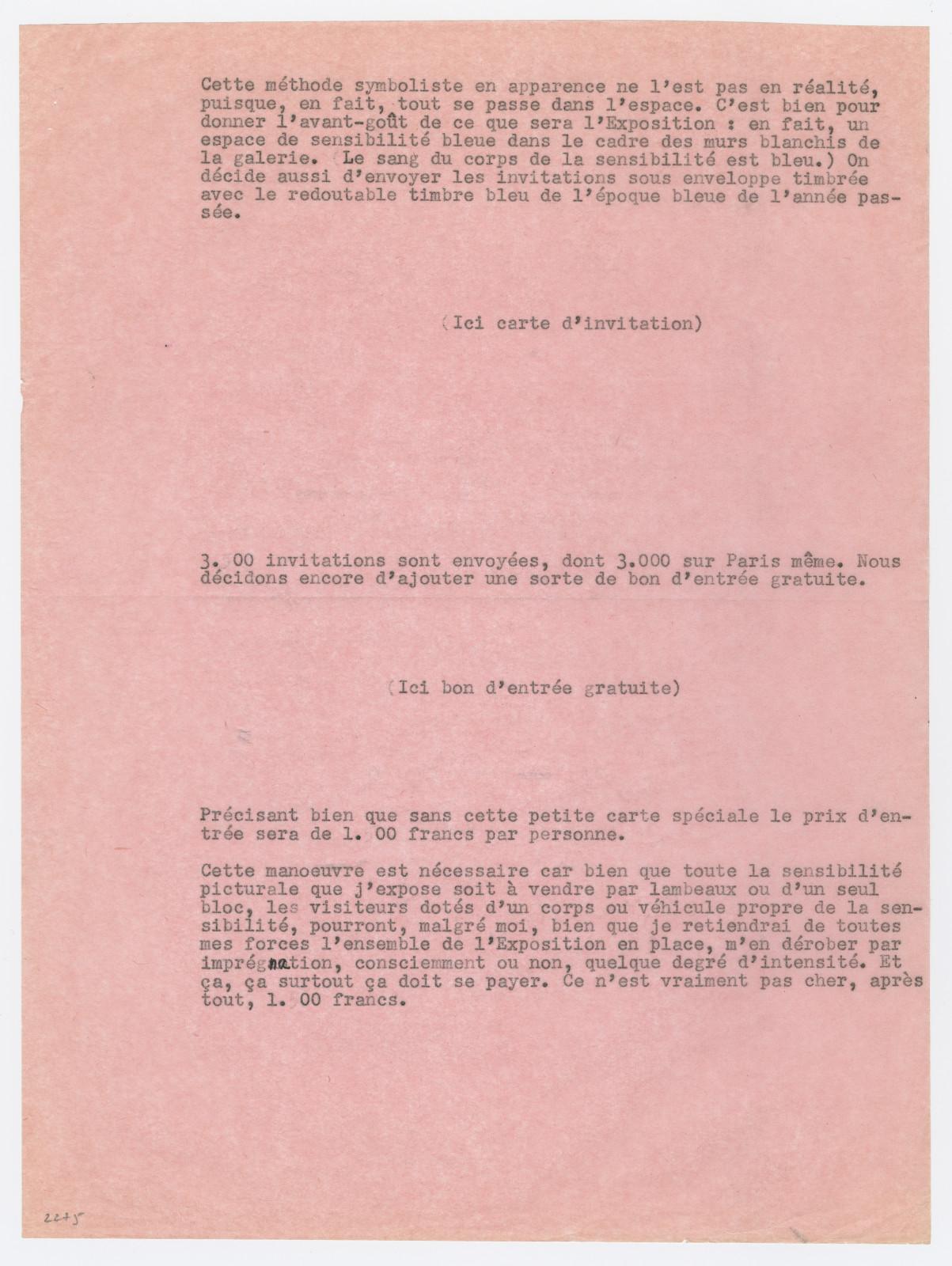
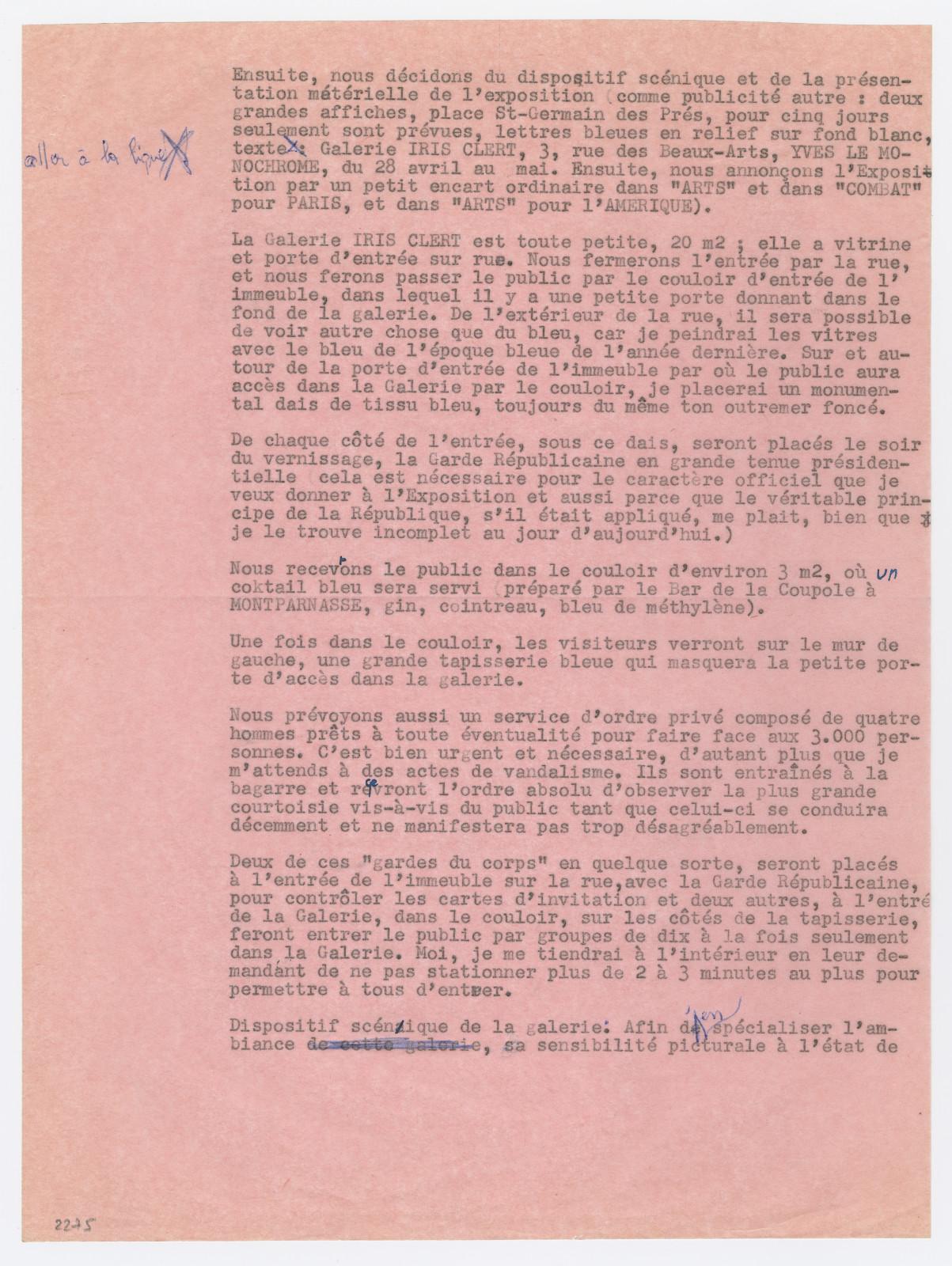
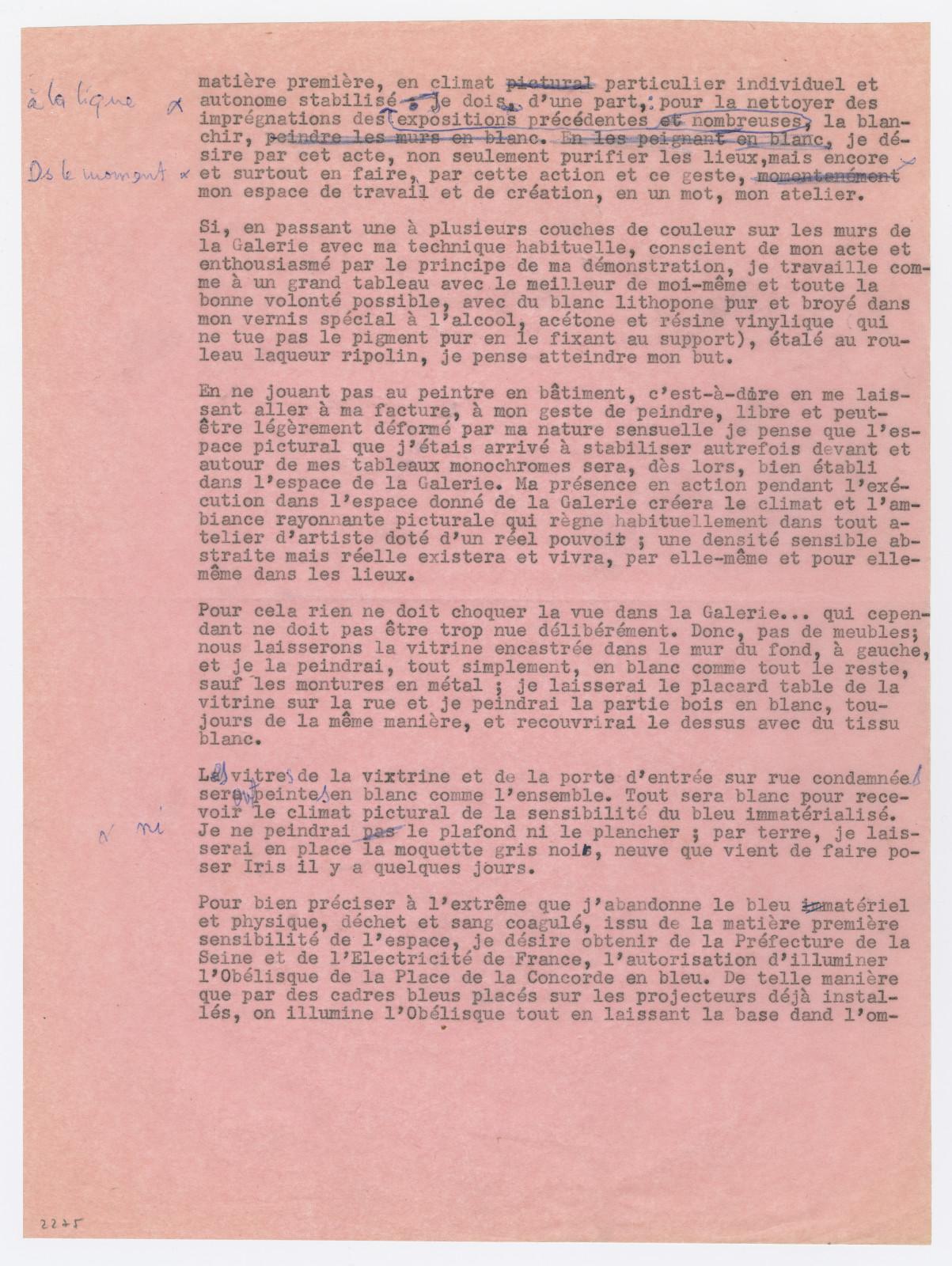
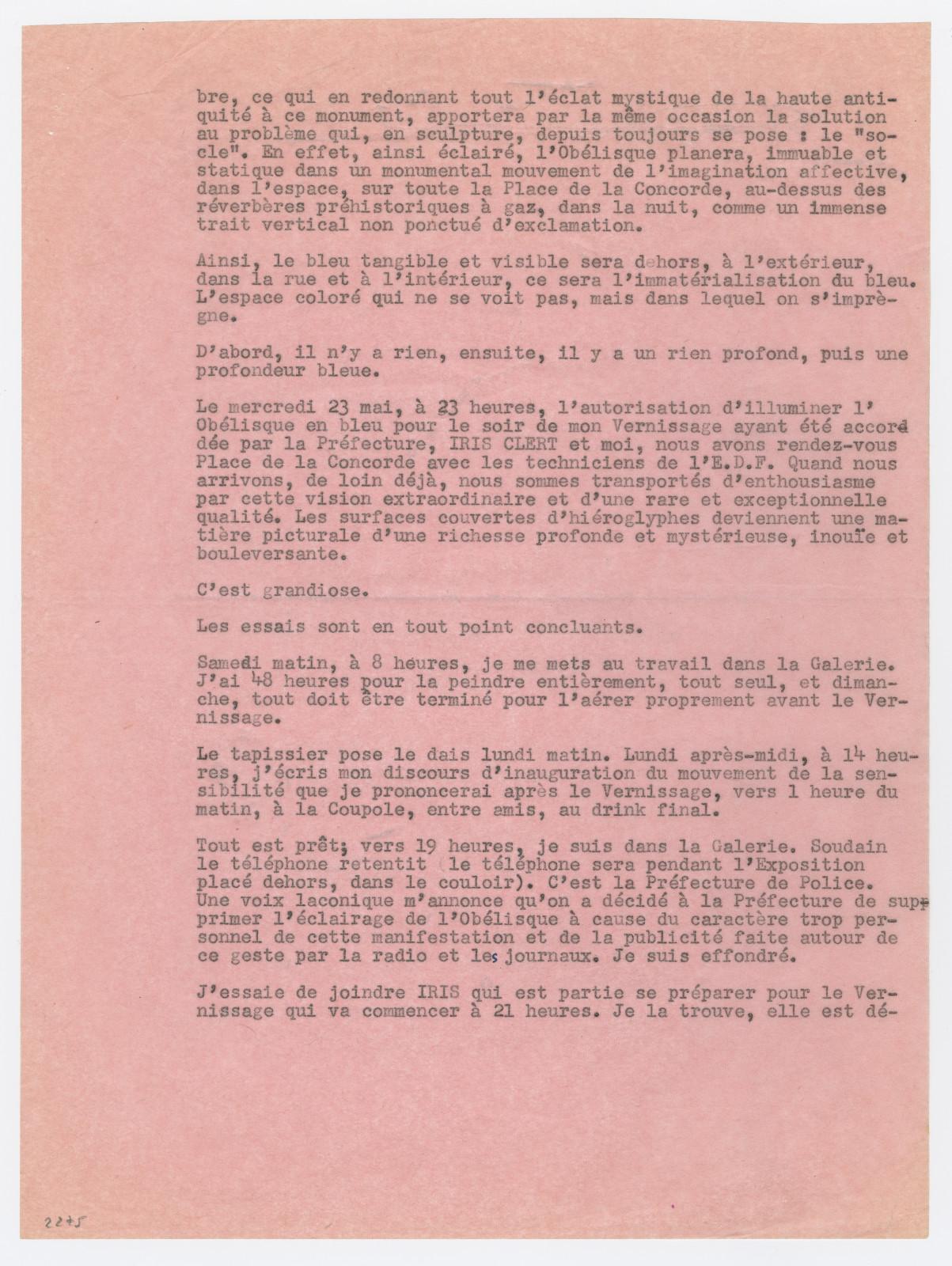
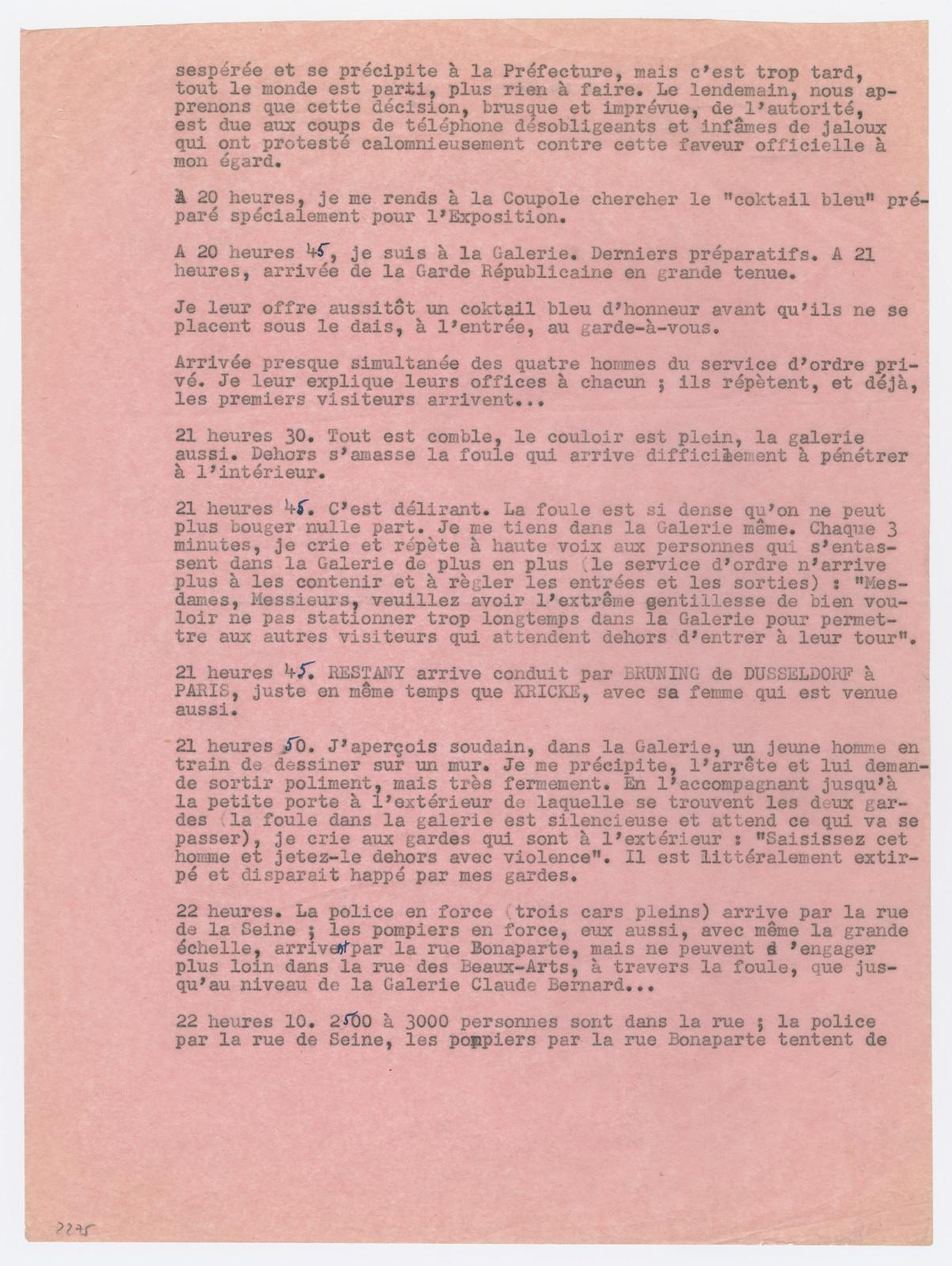
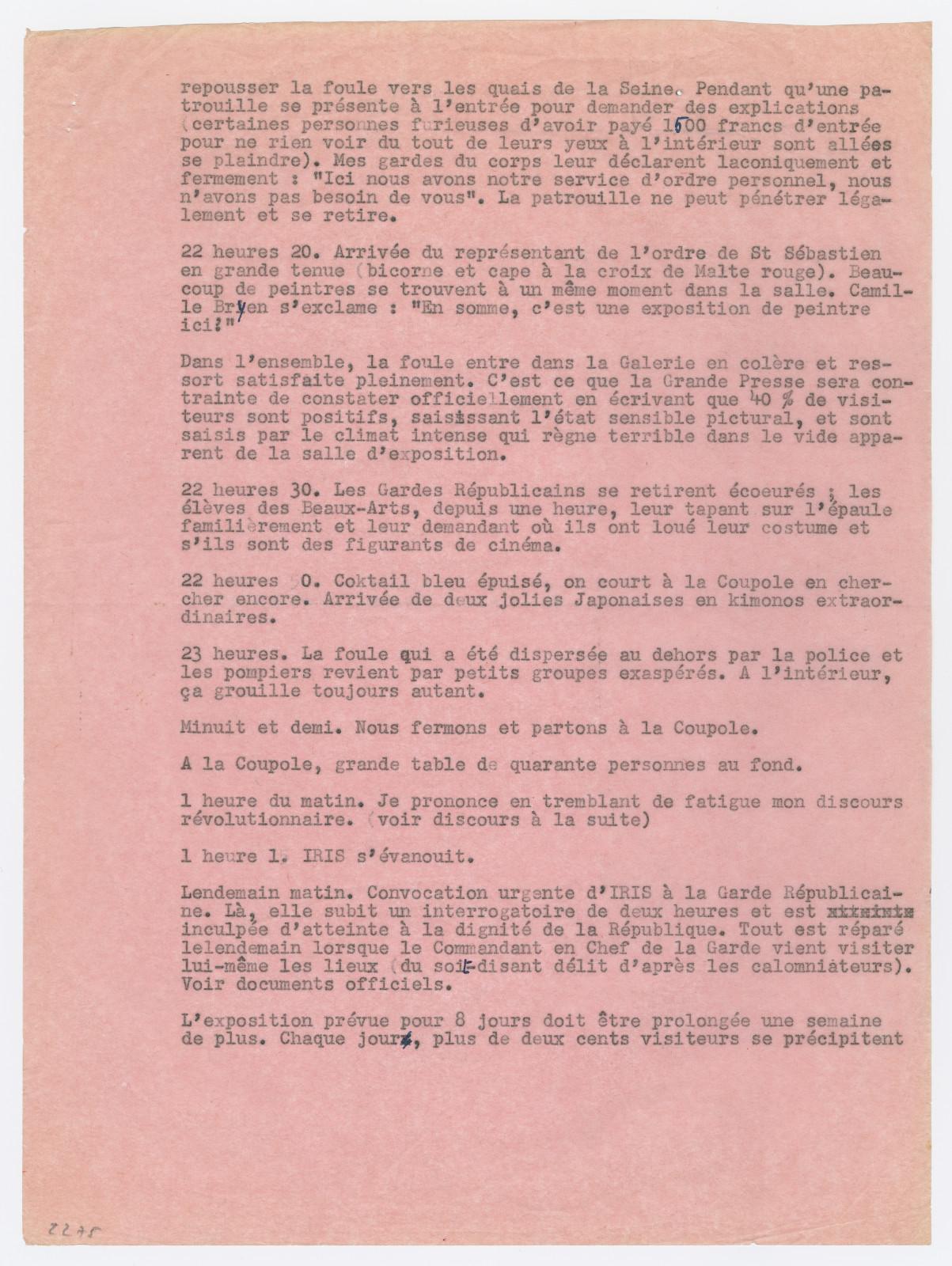
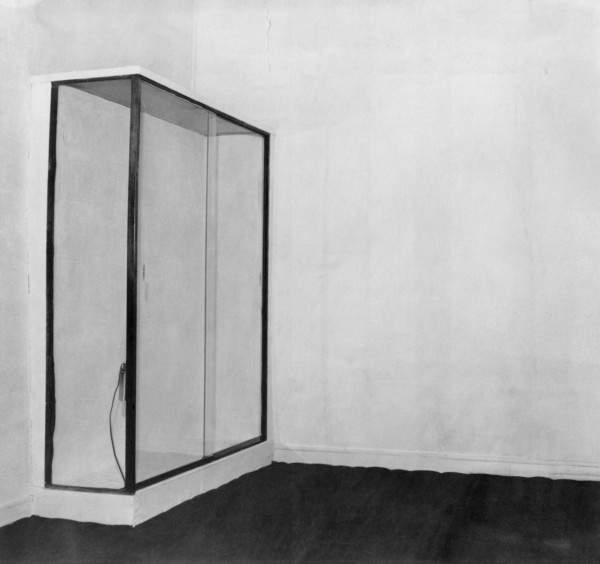
![Yves Klein's exhibition : La spécialisation de la sensibilité à l’état de matière première [The Specialization of Sensibilité in the Raw Material State of Stabilized Pictorial Sensibilité]](/files/film_thumbnail_88.jpg)
![La spécialisation de la sensibilité à l’état matière première en sensibilité picturale stabilisée, "Le Vide" [The Specialization of Sensibility in the Raw Material State into Stabilized Pictorial Sensibility, "The Void"]](/files/exhibition_thumbnail_1158.jpeg)